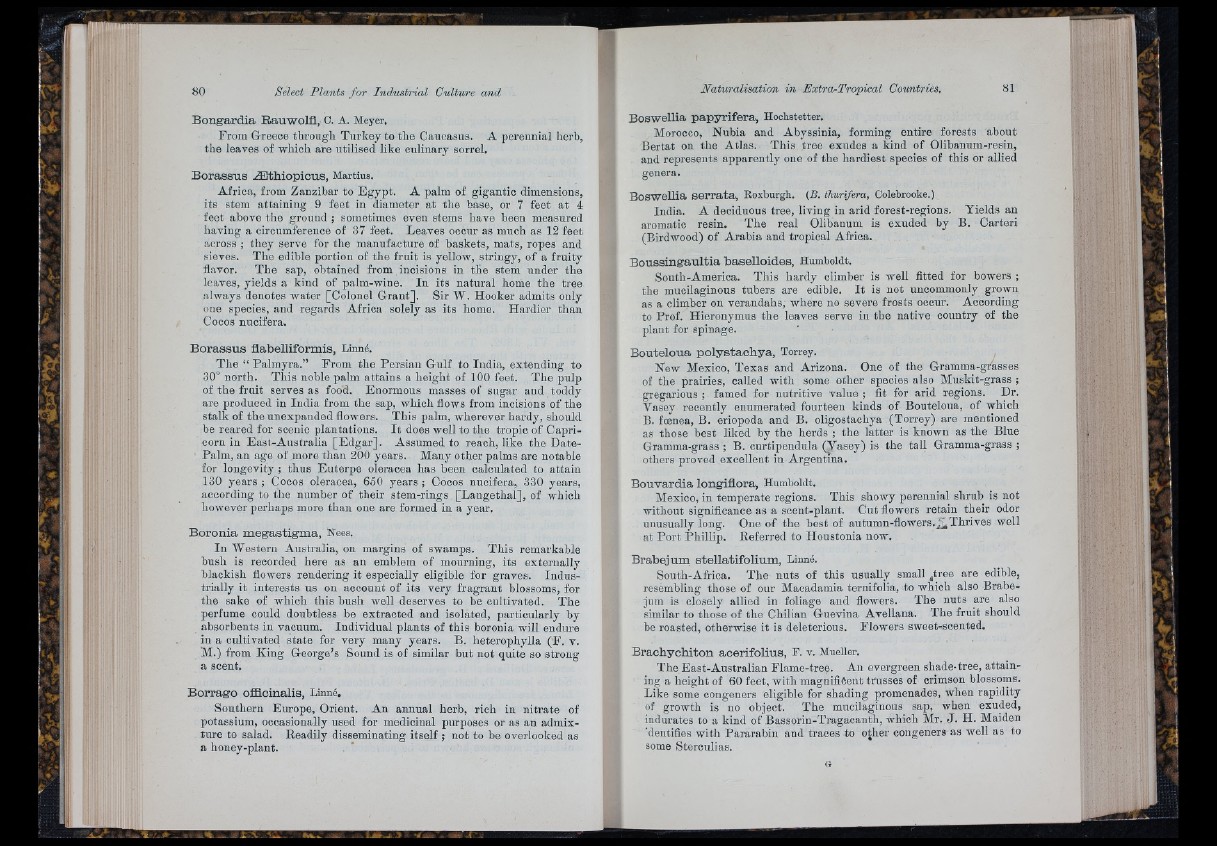
B o n g a rd ia R a uw o lfl, C. A. Meyer.
From Greece through Turkey to the Caucasus. A perennial herb,
the leaves of which are utilised like culinary sorrel.
B o r a s s u s Æ th io p ic u s , Martius.
Africa, from Zanzibar to Egypt. A palm of gigantic dimensions,
its stem attaining 9 feet in diameter at the base, or 7 feet a t 4
feet above the ground ; sometimes even stems have been measured
having a circumference of 37 feet. Leaves occur as much as 12 feet
across ; they serve for the manufacture of baskets, mats, ropes and
sieves. The edible portion of the fruit is yellow, stringy, of a fruity
flavor. The sap, obtained from incisions in the stem under the
leaves, yields a kind of palm-wine. In its natural home the tree
always denotes water [Colonel Grant]. Sir W. Hooker admits only
one species, and regards Africa solely as its home. Hardier than
Cocos nucífera.
B o ra s s u s ñ a b e llifo rm is , Linné.
The “ Palmyra.” From the Persian Gulf to India, extending to
30° north. This noble palm attains a height of 100 feet. The pulp
of the fruit serves as food. Enormous masses of sugar and toddy
are produced in India from the sap, which flows from incisions of the
stalk of the unexpanded flowers. This palm, wherever hardy, should
be reared for scenic plantations. I t does well to the tropic of Capricorn
in East-Anstralia [E d g a r]. Assumed to reach, like the Date-
Palm, an age of more than 200 years. Many other palms are notable
for longevity ; thus Euterpe olerácea has been calculated to attain
130 years ; Cocos oleraoea, 650 years ; Cocos nucífera, 330 years,
according to the number of their stem-rings [Langethal], of which
however perhaps more than one are formed in a year.
B o ro n ia ru e g a s tigm a , Nees.
In Western Australia, on margins of swamps. This remarkable
busli is recorded here as an emblem of mourning, its externally
blackish flowers rendering it especially eligible for graves. Industrially
it interests us on account of its very fragrant blossoms, for
the sake of which this bush well deserves to be cultivated. The
perfume could doubtless be extracted and isolated, particularly by
absorbents in vacuum. Individual plants of this boronia will endure
in a cultivated state for very many years. B. heterophylla (F . v.
M.) from King George’s Sound is of similar but not quite so strong
a scent.
B o rra g o offlcina lis, Linné.
Southern Europe, Orient. An annual herb, rich in nitrate of
potassium, occasionally used for medicinal purposes or as an admixture
to salad. Readily disseminating itself ; not to be overlooked as
a honey-plant.
B o sw e llia p a p y r if e r a , Hochstetter.
Morocco, Nubia and Abyssinia, forming entire forests about
Bertat on the Atlas. This tree exudes a kind of Olibanum-resin,
and represents apparently one of the hardiest species of this or allied
genera.
BosweUia s e r r a ta , Roxburgh. (B. tlmrifera, Colebrooke.)
India. A deciduous tree, living in arid forest-regions. Yields an
aromatic resin. The real Olibanum is exuded by B. Carter!
(Birdwood) of Arabia and tropical Africa.
B o u s s in g a u l ti a b a s e llo id .e s , Humboldt.
South-America. This hardy climber is well fitted for bowers ;
the mucilaginous tubers are edible. I t is not uncommonly grown
as a climber on verandahs, where no severe frosts occur. According
to Prof. Hieronymus the leaves serve in the native country of the
plant for spinage.
B o u te lo u a p o ly s t a o h y a , Torrey.
New Mexico, Texas and Arizona. One of the Gramma-grasses
of the prairies, called with some other species also Muskit-grass ;
gregarious ; famed for nutritive value ; fit for arid regions. Dr.
Vasey recently enumerated fourteen kinds of Bouteloua, of which
B. foenea, B. eriopoda and B. oligostaohya (Torrey) are mentioned
as those best liked by the herds ; the latter is known as the Blue
Gramma-grass ; B. curtipendula (Vasey) is the tall Gramma-grass ;
others proved excellent in Argentina.
B o u v a rd ia lo n g iflo ra , Humboldt.
Mexico, in temperate regions. This showy perennial shrub is not
without significance as a soent-plant. Cut flowers retain their odor
unusually long. One of the best of autumn-flowers.j;i,Thrives well
at Port Phillip. Referred to Houstonia now.
B rab e jum s te lla tifo lium , Linné.
South-Africa. The nuts of this usually small ^tree are edible,
resèmbling those of our Macadamia ternifolia, to which also Brabejum
is closely allied in foliage and flowers. The nuts are also
similar to those of the Chilian Guevina Avellana. The fruit should
be roasted, otherwise it is deleterious. Flowers sweet-scented.
B ra c h y o h ito n a o e rifo liu s , F. v. Mueller.
The East-Australian Flame-tree. An evergreen shade-tree, attaining
a height of 60 feet, with magnificent trusses of crimson blossoms.
Like some congeners eligible for shading promenades, when rapidity
of growth is no object. The mucilaginous sap, when exuded,
indurates to a kind of Bassorin-Tragacanth, which Mr. J . H. Maiden
'dentifies with Pararabin and traces to other congeners as well as to
some Sterculias.
a